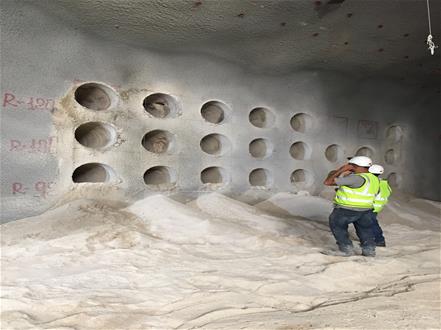“Har HaMenuchot is the largest cemetery in Jerusalem, Israel. The hilltop burial ground lies at the western edge of the city adjacent to the neighborhood of Givat Shaul, with commanding views of Mevaseret Zion to the north, Motza to the west, and Har Nof to the south. Opened in 1951 on 300 dunams of land, it has continually expanded into new sections on the northern and western slopes of the hill.”*
One of its latest expansions has not been above ground but below. The Israeli burial organisation teamed up with Rolzur Eternal Green Solutions to revive the use of catacombs for burial purposes. Structural design of excavation and support is made by A. Rozen Engineering, a local office specializes in tunnel engineering with experience of over 40 years. The underground cemetery first phase has room for 22,000 burial spots. In 2015 the project was nominated for a ITA-Tunnelling Award, under the category of innovative use of underground space.
The Har HaMenuchot project is classed as a large tunnel and pillar system the tunnel is 16 meters high and 14 meters wide with reinforced shotcrete and rockbolts, inside the core of the mountain. The graves are drilled into the tunnel walls using a special custom-made driller which is 75 cm in diameter.
The site was investigated using a geological survey to determine the appropriate paths in order to avoid potential geological obstacles. Engineer Dan Tzuker from A. Rozen Engineering explained that “The geology is characterized by strong and hard dolomitic to limestone rock masses, but fault zones and large open cracks needed to be considered while designing the closed-in drills used for burial chambers’’.
Rolzur excavated the tunnels mainly with roadheaders instead of using the drill & blast technique, with the intention of minimizing the disturbance to the daily “business” of the cemetery. The project’s requirements for ventilation, fire safety and accessibility led the company to design a main shaft. The shaft dimensions are 23m by 19m with a 55m depth that will eventually include elevators, an air plenum, staircases and service chambers. The shaft will also act as a burial “building” that will accommodate more than 3,000 graves on 10 floors.
The negative ventilation system based on the suction of air from the underground space will include ducts with motorized dampers that are governed by a central computerized system. The underground burial space is a new concept in the tunnelling world.

Rolzur have investigated all the potential risks from every angle. Their unique fire safety procedures have been developed with the Israeli Fire and Rescue Services, which will use design codes to evacuate people (visitors and workers) safely and quickly to the assembly points. State-of-the-art CFD computer software that simulates hazardous fire events has already tested throughout the entire area of the underground cemetery.
The project, which started in 2016, will take at least five more years to complete. But the first burials will take place in late-2017 when the first passages are completed. For further information please click here for a video and here for more on the project itself. For more information on Rolzer visit their website http://rolzur.com/. 29/17

